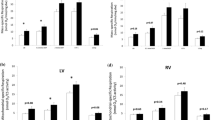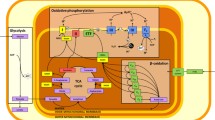Abstract
This study tried to differentiate the consequences of chronic hypoxia on the electrophysiological and physiological properties and the histological characteristics of slow and fast muscles in rats. Animals inhaled a 10% O2 concentration for a 1-month period. Then, slow [soleus (SOL)] and fast [extensor digitorum longus (EDL)] muscles were analyzed in vitro by physiological and electrophysiological measurements and histological analyses. The results were compared to those obtained in corresponding muscles of an age-matched normoxic group. After exposure to hypoxia: (1) in SOL, there was a tendency to elevated Fmax, a significant increase in twitch force and tetanic frequency and a shortening of M-wave duration, and a reduced percentage of type I fibres, whereas the proportion of type IIa fibres doubled; (2) in EDL, Fmax and tetanic frequency were lowered, the muscle became less resistant to fatigue, and the proportion of type IId/x fibres was halved. Then, after 1 month of hypoxia, in the SOL muscle, both the contractile and histological properties resemble those of a fast muscle. By contrast, the EDL became slower, despite its histology was modestly affected. Reduced muscle use in hypoxia could explain the tendency for deteriorating adaptations in EDL, and the faster properties of SOL could result from hypoxia-induced inhibition of the growth-related fast-to-slow shift in muscle fibre types.



Similar content being viewed by others
References
Abdelmalki A, Fimbel S, Mayet-Sornay MH, Sempore B, Favier R (1996) Aerobic capacity and skeletal muscle properties of normoxic and hypoxic rats in response to training. Pflugers Arch 431:671–679
Badier M, Guillot C, Danger C, Tagliarini F, Jammes Y (1999) M-wave changes after high and low frequency electrically induced fatigue in different muscles. Muscle Nerve 22:488–496
Balwin KM (1996) Effect of spaceflight on the functional, biochemical, and metabolic properties of skeletal muscle (review). Med Sci Sports Exerc 28:983–987
Bar A, Pette D (1988) Three fast myosin heavy chains in adult rat skeletal muscle. FEBS Lett 235:153–155
Bigard AX, Brunet A, Guezennec CY, Monod H (1991) Skeletal muscle changes after endurance training at high altitude. J Appl Physiol 71:114–121
Bigard AX, Brunet A, Guezennec CY, Monod H (1991) Effects of chronic hypoxia and endurance training on muscle capillarity in rats. Pflugers Arch 419:225–229
Bigard AX, Sanchez H, Birot O, Serrurier B (2000) Myosin heavy chain composition of skeletal muscles in young rats growing under hypobaric hypoxia conditions. J Appl Physiol 88:479–486
Bowie W, Cumming GR (1971) Sustained handgrip-reproducibility: effects of hypoxia. Med Sci Sports 3:24–31
Brooke MH, Kaiser KK (1970) Muscle fibre types: how many and what kind? Arch Neurol 23:369–379
Caquelard F, Burnet H, Tagliarini F, Cauchy E, Richalet JP, Jammes Y (2000) Effects of prolonged hypobaric hypoxia on human skeletal muscle function and electromyographic events. Clin Sci 98:329–337
Clausen T (2003) Na+–K+ pump regulation and skeletal muscle contractility. Physiol Rev 83:1269–1324
Delp MD, Duan C (1996) Composition and size of type I, IIa, IId/x, and IIb fibres and citrate synthase activity of rat muscle. J Appl Physiol 80:261–270
Desaphy JF, Pierno S, Leoty C, George AL Jr, De Luca A, Conte Camerino D (2001) Skeletal muscle disuse induces fibre type-dependant enhancement of Na+ channel expression. Brain 124:1100–1113
Desplanches D, Mayet MH, Sempore B, Flandrois R (1987) Structural and functional responses to prolonged hindlimb suspension in rat muscle. J Appl Physiol 63:558–563.
Desplanches D, Mayet MH, Ilyina-Kakueva EI, Sempore B, Flandrois R (1990) Skeletal muscle adaptation in rats flown on cosmos 1667. J Appl Physiol 68:48–52
Desplanches D, Hoppeler H, Tüscher L, Mayet MH, Spielvogel H, Ferretti G, Kayser B, Leuenberger M, Grünenfelder A, Favier R (1996) Muscle tissue adaptations of high-altitude natives to training in chronic hypoxia or acute normoxia. J Appl Physiol 81:1946–1951
Dousset E, Steinberg JG, Ballon N, Jammes Y (2001) Effects of acute hypoxia on force and surface EMG during sustained handgrip. Muscle Nerve 24:363–371
Esau SA, Bellemare F, Grassino A, Permutt S, Roussos C, Pardy RL (1983) Changes in relaxation rate with diaphragmatic fatigue in humans. J Appl Physiol 54:1353–1360
Fulco CS, Rock PB, Cymerman A (2000) Improving athletic performance: is altitude residence or altitude training helpful? Aviat Space Environ Med 71:162–171
Garner SH, Sutton JR, Burse RL, McComas AJ, Cymerman A, Houston CS (1990) Operation Everest II: neuromuscular performance under conditions of extreme simulated altitude. J Appl Physiol 68:1167–1172
Guth L, Samaha FJ (1969) Qualitative differences between actomyosin ATP-ase of slow and fast mammalian muscles. Exp Neurol 25:138–152
Hirofuji C, Ishihara A, Itoh K, Itoh M, Taguchi S, Takeuchi-Hayashi H (1992) Fibre type composition of the soleus muscle in hypoxia-acclimatized rats. J Anat 181:327–333
Hochachka PW (1994) Muscles as molecular and metabolic machines. CRC Press, Boca Raton
Ishihara A, Itoh M, Itoh K, Hirofuji C, Hayashi H (1994) Hypobaric-hypoxic exposure and histochemical responses of soleus muscle fibres in the rat. Acta Histochem 96:74–80
Ishihara A, Itoh K, Oishi Y, Itoh M, Hirofuji C, Hayashi H (1995) Effect of hypobaric hypoxia on histochemical fibre-type composition and myosin heavy chain isoform component in the rat soleus muscle. Pflugers Arch 429:601–606
Itoh M, Itoh K, Taguchi S, Hirofuji C, Takeuchi-Hayashi H (1992) Effect of hypobaric hypoxia and fibre type composition of the soleus muscle in the developing rats. Aviat Space Environ Med 63:583–587
Jammes Y, Collett P, Lenoir P, Lama A, Berthelin F, Roussos Ch (1991) Diaphragmatic fatigue produced by constant or modulated electric currents. Muscle Nerve 14:27–34
Kass LJ, Bazzy AR (2001) Chronic hypoxia modulates diaphragm function in the developing rats. J Appl Physiol 90:2325–2329
Kayser B, Hoppeler H, Claassen H, Cerretelli P (1991) Muscle structure and performance capacity of Himalayan Sherpas. J Appl Physiol 70:1938–1942
Kupa EJ, Roy SH, Kandarian SC, De Luca CJ (1995) Effects of muscle fibre type and size on EMG median frequency and conduction velocity. J Appl Physiol 79:23–32
Laframboise WA, Daood MJ, Guthrie RD, Moretti P, Schiaffino S, Ontell M (1990) Electrophoretic separation and immunological identification of type II x myosin heavy chain in rat skeletal muscle. Biochim Biophys Acta 1035:109–112
Orizio C, Esposito F, Veicsteinas A (1994) Effect of acclimatization to high altitude (5,050 m) on motor unit activation pattern and muscle performance. J Appl Physiol 77:2840–2844
Pierno S, Desaphy JF, Liantonio A, De Bellis M, Bianco G, De Luca A, Frigeri A, Nicchia P, Svelto M, Leoty C, George AL Jr, Camerino Conte D (2002) Change of chloride ion channel conductance is an early event of slow-to-fast type transition during unloading-induced muscle disuse. Brain 125:1510–1521
Pette D, Staron RS (2000) Myosin isoforms, muscle fibre types, and transitions. Microsc Res Tech 50:500–509
Schiaffino S, Gorza L, Sartore S, Saggin L, Ausino S, Vianello M, Gundersen K, Lomo T (1989) Three myosin heavy chain isoforms in type II skeletal muscle fibres. J Muscle Res Cell Motil 10:197–205
Sillau AH, Branchero N (1977) Effects of hypoxia on capillary density and fibre composition in rat skeletal muscle. Pflugers Arch 370:227–232
Staron RS, Kraemer WJ, Hikida RS, Fry AC, Murray JD, Campos GER (1999) Fibre type composition of four hindlimb muscles of adult Fisher 344 rats. Histochem Cell Biol 111:117–123
Takahashi H, Kikuchi K, Nakayama H (1992) Effect of chronic hypoxia on skeletal muscle fibre type in adult male rats. Ann Physiol Anthropol 11:625–630
Talmadge RJ (2000) Myosin heavy chain isoform expression followng reduced neuromuscular activity: potential regulator mechanisms (review). Muscle Nerve 23:661–679
Young A, Wright J, Knapick J, Cymerman A (1980) Skeletal muscle strength during exposure to hypobaric hypoxia. Med Sci Sports Exer 12:330–335
Author information
Authors and Affiliations
Corresponding author
Rights and permissions
About this article
Cite this article
Faucher, M., Guillot, C., Marqueste, T. et al. Matched adaptations of electrophysiological, physiological, and histological properties of skeletal muscles in response to chronic hypoxia. Pflugers Arch - Eur J Physiol 450, 45–52 (2005). https://doi.org/10.1007/s00424-004-1370-6
Received:
Revised:
Accepted:
Published:
Issue Date:
DOI: https://doi.org/10.1007/s00424-004-1370-6




